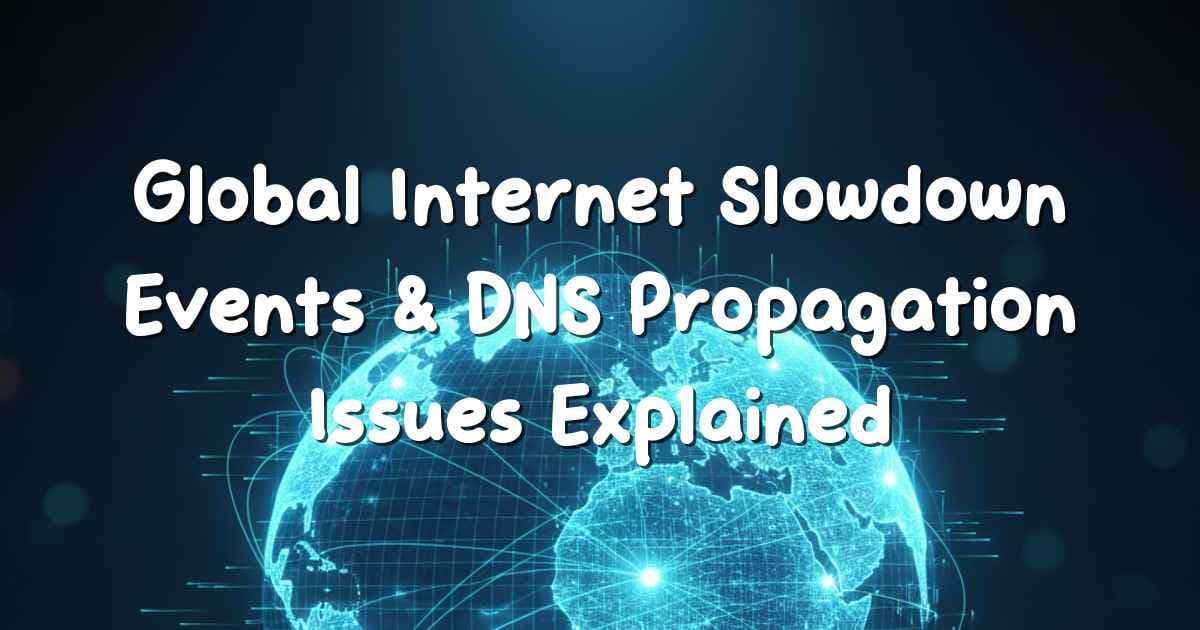
Global Internet Slowdown Events & DNS Propagation Issues Explained
Why the internet slows down worldwide, why DNS fails randomly, and what users can do to fix it.
What Are Global Internet Slowdown Events?
A global slowdown event is when a major part of the internet experiences increased latency, packet loss, or temporary outages. These issues don’t affect all websites equally some remain fast, others become painfully slow, and a few may refuse to load at all.
These slowdowns happen when something disrupts the internet’s core infrastructure, such as:
1. Backbone Routing Shifts
Internet traffic moves through huge fiber networks called backbones. When one backbone becomes overloaded or faces technical issues, traffic is rerouted to alternative paths. This rerouting can cause:
- Temporary congestion
- Slower connection speeds
- Longer travel paths for packets
- Missing routes to certain servers
It’s similar to closing a major highway: the side roads quickly get jammed.
2. Undersea Cable Issues
Over 95% of global internet traffic flows through undersea fiber optic cables. Damage or maintenance on these cables can create:
- Regional outages
- High latency
- Increased packet loss
- Difficulty accessing foreign websites
Countries dependent on a limited number of cables (many Asian, Middle-Eastern & African nations) feel these disruptions more deeply.
3. CDN (Content Delivery Network) Latency Spikes
Platforms like Cloudflare, Akamai, and Amazon CloudFront act as global delivery hubs. If a CDN node becomes overloaded:
- Images load slowly
- Pages become partially broken
- Websites fail randomly
Since thousands of websites depend on the same CDN, millions feel the slowdown at once.
4. ISP-Level Throttling or Routing Errors
Your Internet Service Provider sometimes faces:
- Peering issues with other networks
- Temporary link congestion
- DNS resolver problems
Even if the global internet is fine, your local ISP can cause widespread slowdown for its users.
What Is DNS and Why Does It Fail?
DNS (Domain Name System) is often described as the “phonebook of the internet.” When you type a website address, DNS translates it into the actual IP address of the server.
When DNS fails, you get errors like:
- “Server not found”
- “DNS probe finished NXDOMAIN”
- “Site can’t be reached”
Even if the website is up and running, DNS issues on your network can make it appear offline.
Why DNS Propagation Causes Problems
Whenever a domain changes hosting, nameservers, or IP addresses, DNS must update across thousands of global servers. This process, called DNS propagation, takes:
- 30 minutes for fast networks
- Up to 48 hours for slower ones
During propagation, users may see:
- Old site one moment
- New site next moment
- Temporary errors
- Mixed content loading
Propagation is not something you can speed up globally but you can troubleshoot locally.
Why These Issues Suddenly Go Viral Online
There are a few reasons why millions talk about this at the same time:
1. Everyone Feels the Issue SIMULTANEOUSLY
Routing events and CDN outages affect:
- Streaming services
- Social media
- Banking platforms
- Shopping websites
- Cloud-based apps
When people can’t load Instagram, YouTube, or payment gateways, they instantly assume the entire internet is broken.
2. No Official Explanation From ISPs or CDNs
Most backbone providers do not communicate outages publicly. ISPs also announce issues only after the damage is done or remain silent entirely.
This lack of clarity causes panic.
3. Users Mistake Global Issues as Local Problems
People restart routers, reinstall apps, and still find nothing improves. So they head to Twitter, Reddit, or Telegram and soon realize:
“It’s not just me it’s everyone.”
This makes the topic spread fast across the internet.
How to Know if a Slowdown Is Global, Not Just You
Here are reliable methods:
✔️ 1. Check Downdetector (But with Caution)
Downdetector reports spikes quickly but may show false positives during global routing hiccups.
✔️ 2. Ping a Global DNS (Google or Cloudflare)
Open Command Prompt or Terminal and run:
ping 8.8.8.8
ping 1.1.1.1
If packet loss is high or latency spikes, the issue is likely worldwide.
✔️ 3. Verify with Web Tools
Use:
- Cloudflare Status
- Google Cloud Status
- AWS Status
- Fast.com
- Internet Outage Map tools
If multiple services show issues, it’s global.
How to Fix Internet Slowdown & DNS Problems (Step-by-Step)
Even if the issue is global, you can still improve your local experience.
How-To Guide: Fixing DNS & Slow Internet Issues
1. Change Your DNS Server
Switching to a faster DNS can immediately fix loading issues.
Recommended DNS Servers
| Provider | DNS Address |
| Google DNS | 8.8.8.8 / 8.8.4.4 |
| Cloudflare DNS | 1.1.1.1 / 1.0.0.1 |
| Quad9 Security DNS | 9.9.9.9 |
How to Change DNS (Windows)
- Open Control Panel
- Go to Network & Internet > Network Connections
- Right-click your active network → Properties
- Select Internet Protocol Version 4 (TCP/IPv4)
- Click Use the following DNS
- Enter new DNS
- Save and restart
2. Flush Your Local DNS Cache
Sometimes your PC stores outdated DNS entries.
Windows Command:
ipconfig /flushdns
macOS Command:
sudo killall -HUP mDNSResponder
3. Restart Router and Switch Network Band
Try switching between:
- 2.4 GHz WiFi
- 5 GHz WiFi
- Mobile hotspot
- Wired connection
This helps bypass local ISP congestion.
4. Disable VPN or Switch Location
VPN servers often get overloaded during global outages.
Try:
- Turning VPN off
- Connecting to closer VPN region
If you rely on a VPN for work, choose a server with low ping.
5. Clear Browser Cache & DNS
A corrupt browser cache can cause partial site loading.
Most browsers allow quick clearing using:
Ctrl + Shift + Delete
6. Temporarily Use a Proxy or CDN Test Node
When certain websites fail, a proxy helps check if the site is actually down.
- web-proxy testing
- CDN caching tools
- Site reachability testers
If the site loads through a proxy, your ISP is the bottleneck.
FAQ: Common Questions About Global Internet Slowdowns
1. Why do websites load randomly some work, others don’t?
Because routing changes affect specific paths, not the entire internet. Different websites use different routes and CDNs.
2. Is my ISP responsible for the slowdown?
Not always. Your ISP only controls the “last mile.” If a backbone provider or undersea cable faces issues, your ISP is also affected.
3. Why do DNS errors happen even when the site is online?
Your DNS resolver may have outdated or corrupted entries. Flushing DNS or switching DNS providers usually fixes this.
4. How long do global routing issues last?
Usually:
- Minor events → 10–60 minutes
- Major cable outages → several hours
- Propagation-related issues → up to 48 hours
5. Should I use a VPN during global slowdowns?
Only if your region’s routing is affected. A VPN may help by routing traffic through a healthier path.
6. Can I speed up DNS propagation?
No. Propagation happens worldwide and cannot be forced. You can only fix local caching.
7. Why do such outages feel more common now?
Because:
- More users rely on cloud services
- Social platforms amplify complaints
- Global infrastructure carries far more traffic
- CDN dependency has skyrocketed
Even a small hiccup affects millions instantly.
Conclusion
Global internet slowdowns and DNS issues aren’t mysterious they’re the result of complex routing systems, backbone traffic changes, undersea cable problems, and overloaded CDNs. While you can’t prevent global outages, you can improve your local network experience with the steps provided in this guide.
The next time the internet seems broken, you’ll know exactly what’s happening and how to fix it.




